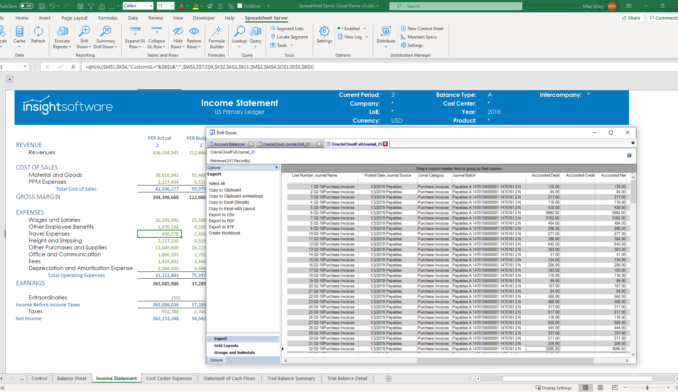What does your planning, budgeting, and forecasting process look like? Are you satisfied with how smooth, efficient, and hassle-free it is? If the answer is “no,” how will you improve it in the coming year?
Planning, budgeting, and forecasting no longer have to be an annual, quarterly, or even monthly plague. Read on to learn some best practices that will make these processes painless and enable better business decisions.
Turn Planning from Problematic into a Piece of Cake
For many companies, planning is an enormous headache. That’s unfortunate, because it’s a vital part of a firm’s success: Planning helps them determine what their financial needs and goals are for the coming year and how to achieve them. Without that knowledge, businesses can run adrift on the shoals of the market.
Why is planning so problematic? It has a great deal to do with the technology used in the planning process. Many companies rely on Excel. Excel has many strengths, but static spreadsheets are not meant for planning or budgeting; on its own, Excel doesn’t enable real-time collaboration between stakeholders, the data doesn’t automatically refresh because it’s not drawn from an information source, and let’s not get started on the opportunity for manual errors.
Planning is problematic because companies aren’t always using the right technology to do it.
Moreover, other technologies which promise to make the planning, budgeting, and forecasting process easier can actually exacerbate problems. For example, ERP systems don’t have the capacity to export real-time data without a significant investment in infrastructure, so users utilize static Excel spreadsheets to get information out of the ERP system.
How do you solve this dilemma? Businesses need a solution that enables them to extract relevant, accurate data from their ERP systems when they need it so they can respond quickly to situations and make the right decisions.
Budgeting: It Doesn’t Have to be a Nightmare
Many companies also find the budgeting process to be a lengthy, laborious procedure that ultimately frustrates because it doesn’t yield its intended results. Rather, businesses find themselves with out-of-date information that is useless for making critical decisions.
Again, technology plays an important role here. ERP systems and static spreadsheets don’t provide real-time data for decision-makers, and exporting and importing information in and out of ERP systems wastes time and money (and can lead to costly mistakes).
The wrong technology can make budgeting a waste of time and money.
This situation doesn’t have to remain the same year-in and year-out. We’ll use the example of ISS Facility Services to illustrate this point. ISS is a global facilities management firm that operates in 50 countries and brings in billions of dollars of revenue per year. Although it’s a highly successful company, ISS’ director of IT Anthony Lackey realized that the firm’s budgeting process was an obstacle to achieving its goals.
When Lackey joined ISS, he realized that the legacy application system was not meeting the organization’s needs at all. It was a third-party development platform with connections to JD Edwards. Lackey described the application design as “incomplete, inflexible, and non-scalable.” Processes were highly manual and time-consuming.
ISS’ budgeting cycle took approximately four months and cost the firm $320,000. Lackey called the numbers produced from those budgets “garbage.” None of the staff on the ground relied on what came out of JD Edwards. Lackey knew it was time to unify the planning, budgeting, and reporting processes.
Lackey chose Hubble’s business performance management system to transform ISS’ budgeting process into a smooth, hassle-free experience. “It was love at first sight,” he commented. Implementation took under an hour, and ISS users found Hubble to be easy to utilize with an Excel-like interface for simple modeling.
Hubble’s integration with JD Edwards means there’s no more importing data. ISS has access to the most up-to-date information possible directly from its ERP system. Because Hubble allows you to open up multiple planning sessions at once, it supports monthly budgeting, something ISS adopted in 2016.
Lackey pointed to the benefits of adopting Hubble’s business performance management solution: no more creating static Excel spreadsheets, no more manual editing, no more inaccurate information, and high levels of visibility into every level of the business.
Forecasting: Yes, It Can be Hassle-Free
No one can predict the future with exact accuracy. That being said, if you’re using static spreadsheets and stale data from your ERP system to create forecasts, you’re simply looking in the rear-view mirror. Those kinds of forecasts have no value.
The success of your forecasting is inextricably linked to your processes and technology. Manual processes involving spreadsheets or ERP systems that don’t provide you with the most current information won’t yield useful forecasts. In fact, they can actually cost you money; while you rely on data from last month (or even last year), you can’t anticipate market changes or even whether you’ll have enough cash flow to continue operations.
Forecasting is sometimes written off during the planning and budgeting process. However, it’s actually an integral part of it. Operational measures drive financial results, and the top performing companies understand that. In a report released in October 2017 by the Institute of Management Accountants, research showed the correlation between using financial planning and analysis best practices and high levels of performance: More than 94 percent of companies that put these best practices into place outperformed their competitors, while more than 92 percent of these organizations were more profitable.
Another crucial finding in the report was that many top-performing businesses use predictive analytics in their forecasting process. Predictive analytics give these firms an edge; they can not only ask questions about what’s going to happen next, but why it will take place.
Your planning, budgeting, and forecasting processes don’t have to be cost centers, they should be business enablers. A business performance management solution makes that possible by giving you the most up-to-date ERP information when you need it. To learn more, read our guide to vetting and purchasing a BPM solution








